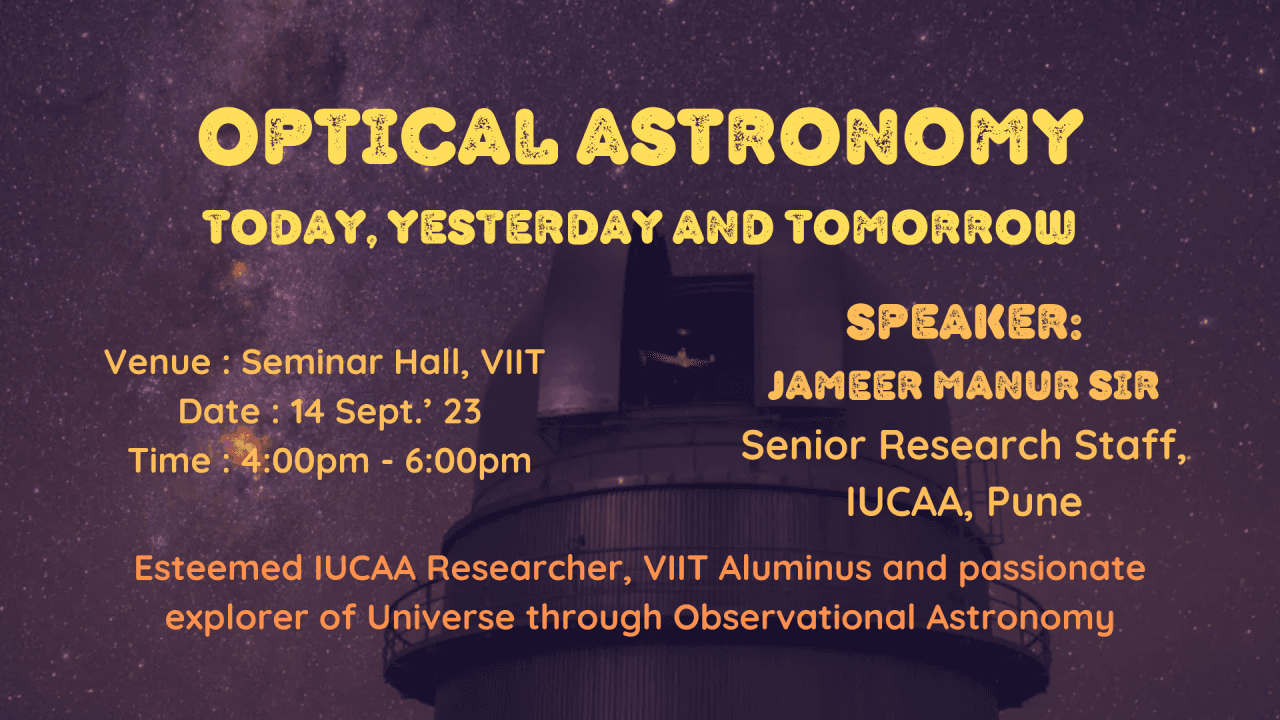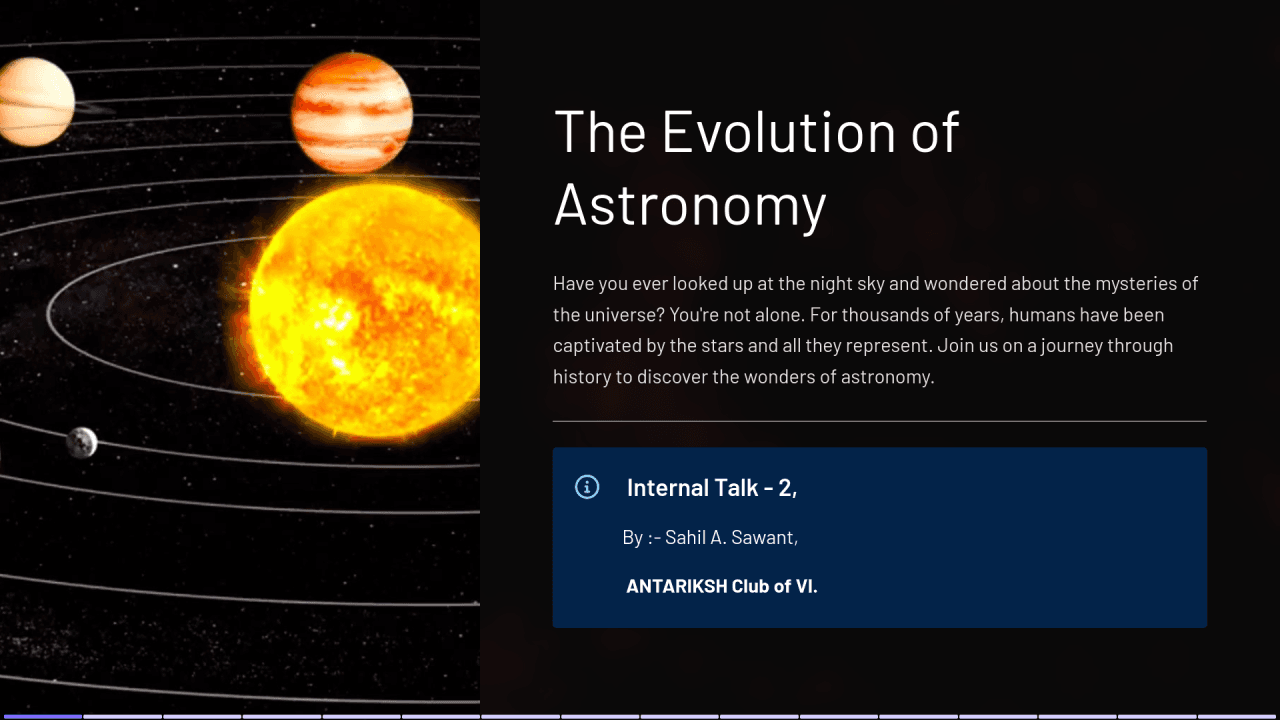Date : September 16, 2023
Venue : Lecture Room B108, Vishwakarma Institute of Information Technology (VIIT), Pune
Organizer : Antariksh - Astronomy Club

Introduction:
On the crisp evening of September 16, 2023, astronomy enthusiasts and curious minds gathered at the Vishwakarma Institute of Information Technology in Pune for an enlightening and captivating internal talk hosted by the Antariksh Club. HARSH JALNEKAR , a core member of the club, took center stage to unravel the mysteries of the universe, focusing on the fascinating topics of "Death of a Star and Introduction to Black Holes."
The Cosmic Journey:
1. Cosmic Drama: How Stars Meet Their End
Harsh Jalnekar began the session by unraveling the dramatic ways in which stars bid farewell to the universe. These included supernovae, hypernovae, gamma-ray bursts, and kilonovae, each a celestial spectacle marking the conclusion of a star's life cycle.
Supernova: A supernova is one of the most spectacular events in the universe. It occurs when a massive star, typically several times more massive than our sun, reaches the end of its life cycle. The star's core collapses under the force of gravity, leading to a rapid increase in temperature and pressure. This results in a violent explosion that outshines an entire galaxy for a brief period.
Hypernova: Hypernovae are even more energetic and rare than supernovae. They occur when extremely massive stars, often 30 times or more massive than the sun, exhaust their nuclear fuel. The core collapse and subsequent explosion are more powerful than a typical supernova, releasing enormous amounts of energy. Hypernovae are associated with the formation of black holes.
Gamma-Ray Burst (GRB): Gamma-ray bursts are incredibly intense and brief flashes of gamma-ray radiation. They can last from milliseconds to several minutes and are among the most energetic events in the universe. While the exact mechanisms behind GRBs are still being studied, they are often associated with the collapse of massive stars or the merger of compact objects like neutron stars.
Kilonova: Kilonovae are intriguing cosmic events resulting from the collision of two neutron stars or a neutron star and a black hole. When these ultra-dense objects come together, they release a tremendous amount of energy in the form of light and other radiation, including gravitational waves. Kilonovae played a crucial role in confirming the existence of gravitational waves and the production of heavy elements in the universe.
2. Stellar Afterlife: White Dwarfs and Neutron Stars
White Dwarf (1914, Henry Russell):
Harsh Jalnekar shed light on the birth of white dwarfs, a process dating back to Henry Russell's pioneering work in 1914. White dwarfs are the remnants of low to medium-mass stars. They are incredibly dense, with a mass comparable to that of the Sun but a size similar to a planet. Spectral analysis and the detection of disturbances in their surroundings allow astronomers to identify these cosmic gems.
Neutron Star (1967, Antony Hewish):
The audience was then introduced to neutron stars, a remarkable class of celestial objects. Antony Hewish's groundbreaking work in 1967 marked a milestone in our understanding of neutron stars. These remnants are born from the catastrophic core collapse of massive stars, resulting in a density so extreme that a teaspoon of neutron star material would weigh as much as a mountain.
Neutron stars exhibit various fascinating phenomena, including radio emission, X-ray emission, gamma emission, and gravitational waves. Attendees learned about pulsars, rapidly rotating neutron stars that can spin hundreds of times per second. Pulsars emit beams of radiation, which, when aligned with Earth, create the regular pulse-like signals that astronomers detect.
The discussion then turned to magnetars, an even more exotic variation of neutron stars. These cosmic oddities are known for their extraordinary magnetic fields, which can tear apart atoms and even disrupt the electron clouds of atoms. The insight into these magnetic powerhouses enriched our understanding of the universe's extreme environments.
3. The Abyss Beckons: Introduction to Black Holes
As the session ventured deeper into the enigmatic realm of black holes, attendees were treated to an extensive introduction that peeled back the layers of mystery surrounding these cosmic wonders.
Black Hole Phenomena:
The journey began by exploring the various phenomena associated with black holes. Attendees were introduced to the concept of accretion disks, swirling rings of matter spiraling into the gravitational abyss of a black hole. This mesmerizing visual representation provided insight into the cosmic feeding frenzy that occurs around these celestial objects.
The presentation illuminated the awe-inspiring phenomenon of gamma-ray bursts (GRBs), one of the most energetic and intriguing events in the universe. Attendees gained an understanding of how these high-energy explosions are linked to the processes occurring around black holes.
Specific Black Holes Brought to Life:
To make the abstract concept of black holes more vivid and tangible, specific black holes were brought into focus. Attendees embarked on a journey to meet cosmic entities such as Gargantula, Triangulum, Sagittarius A, Stephenson, Ton 618, and Phoenix A. These celestial giants, with their distinct characteristics and locations, were brought to life through engaging descriptions and visuals, allowing the audience to connect with these cosmic wonders on a personal level.
Energetic Powerhouses: Active Galactic Nuclei and Quasars:
The session delved into the heart of active galactic nuclei (AGN) and quasars, illuminating their significance as energetic powerhouses in the universe. Attendees were provided with a detailed understanding of how supermassive black holes, nestled at the cores of galaxies, drive the intense energy emissions from these cosmic phenomena.
The role of AGN and quasars in shaping the cosmos was emphasized, highlighting their profound impact on the evolution of galaxies and the vast interstellar landscapes they inhabit.
4. Cosmic Choreography: Black Hole Systems
An enthralling segment of the session explored the intricate dance of celestial bodies within black hole systems. Attendees marveled at the spectacle of planets and binary stars orbiting colossal black holes, gaining insight into the complex gravitational dynamics that govern these cosmic neighborhoods.
In essence, the session was a mesmerizing journey through the life cycles of stars, the enigmatic world of black holes, and the captivating interstellar choreography of celestial bodies. Attendees left with a deeper appreciation of the cosmos, armed with newfound knowledge and a burning curiosity to explore the mysteries of the universe further.
Engaging Q&A Session:
" A participant inquired about the naming conventions for stars and sought additional information about how astronomers classify and name celestial objects.
Response: Harsh Jalnekar elaborated on the process of naming stars, explaining how they are typically designated using a combination of letters, numbers, and constellations. He also delved into the broader topic of astronomical nomenclature, shedding light on the various systems used to categorize and identify celestial objects.
" A curious attendee wanted to know if it was possible for celestial bodies, such as planets or other objects, to exist in the vicinity of magnetars.
Response: Harsh explained that, while theoretically possible, the intense magnetic fields of magnetars make it highly unlikely for planets or other celestial bodies to survive in close proximity. He discussed the extreme conditions near magnetars and the challenges such bodies would face in such an environment.
" A participant inquired about the key differences between pulsars and magnetars, both being types of neutron stars.
Response: Harsh clarified that the primary distinction between pulsars and magnetars lies in their spin intensity. Pulsars are known for their incredibly rapid rotation, often spinning hundreds of times per second, while magnetars are characterized by their exceptionally strong magnetic fields. He further elaborated on the observable characteristics and behavior of these intriguing celestial objects.
" An audience member posed a question regarding the formation of supermassive black holes and whether they are created differently from smaller black holes.
Response: Harsh provided insights into the formation of supermassive black holes, explaining that they are believed to result from the merger and accretion of multiple smaller black holes over cosmic timescales. He emphasized that this process sets supermassive black holes apart from their smaller counterparts and contributes to their immense size and gravitational influence.
" A thought-provoking question was raised about the concept of white holes and whether their discovery could provide insights into the Big Bang.
Response: Harsh clarified that while white holes are intriguing theoretical objects that are the reverse of black holes (expelling matter instead of capturing it), their existence has not been confirmed. He emphasized that white holes do not serve as a direct window into the Big Bang but rather contribute to our understanding of the broader concepts of matter, antimatter, and the laws of physics governing extreme conditions.



Conclusion:
The internal talk by Harsh Jalnekar left attendees in awe of the vastness and complexity of the cosmos. It was a truly enlightening evening, where the Antariksh Club succeeded in making the intricacies of astrophysics accessible and engaging for all. As we look to the stars with newfound knowledge, we anticipate more captivating astronomical explorations from the club in the future.
This event was not only an opportunity for knowledge-sharing but also a reminder of the boundless wonders that await us beyond our own planet.



